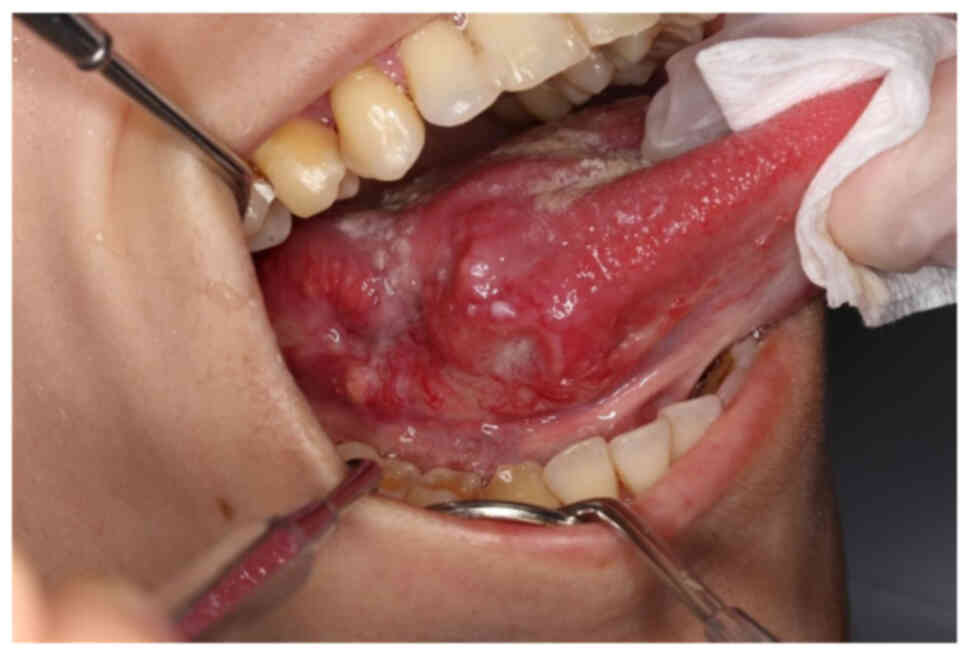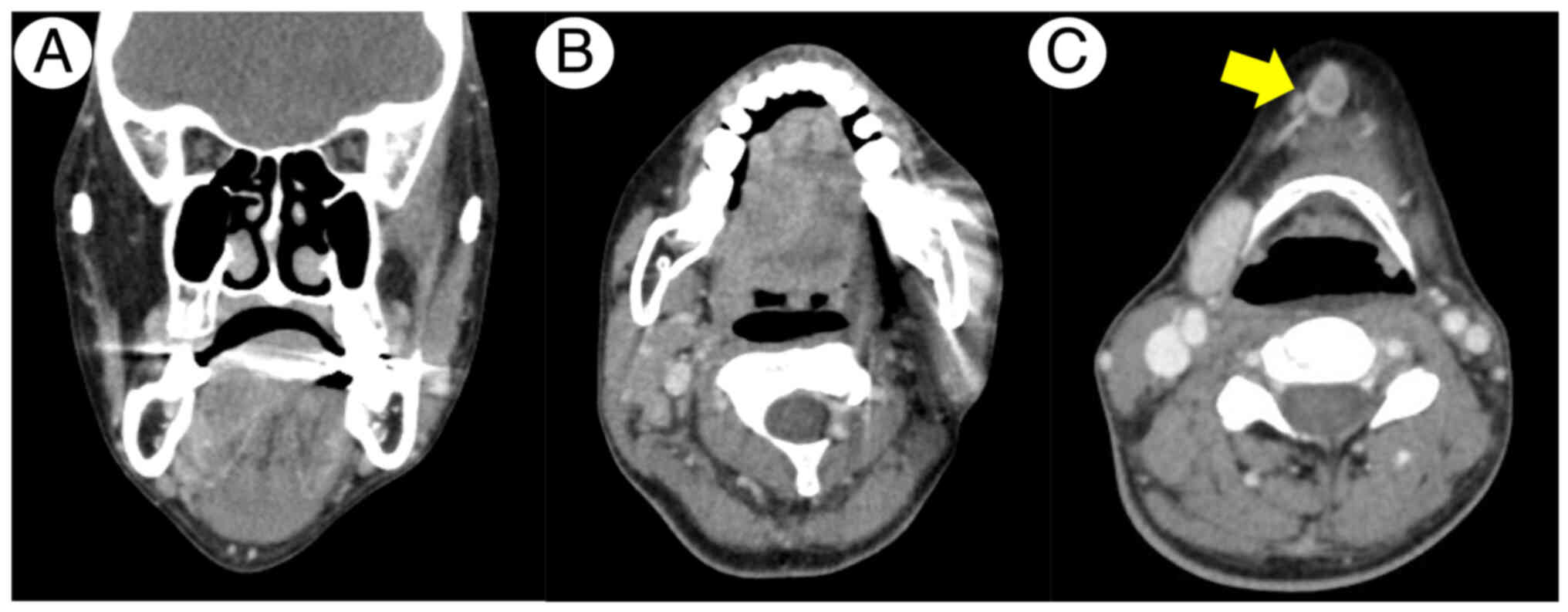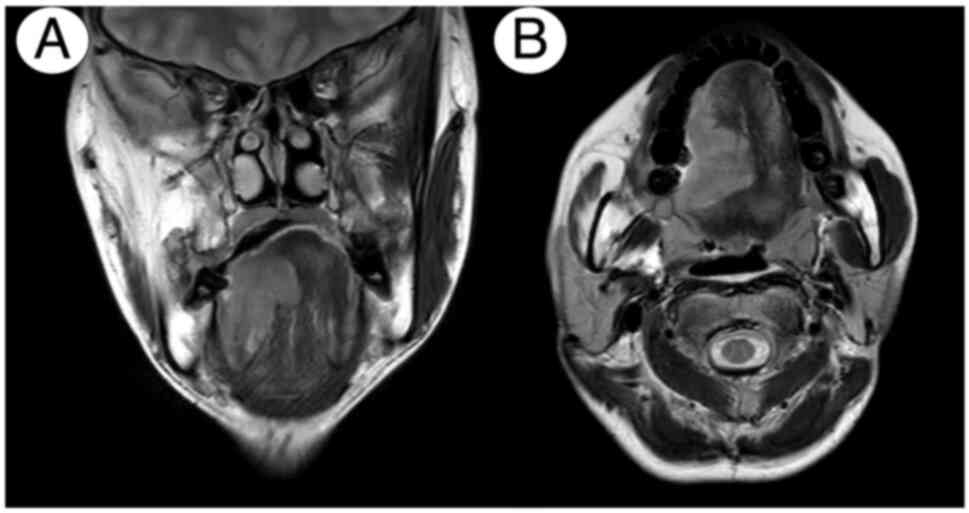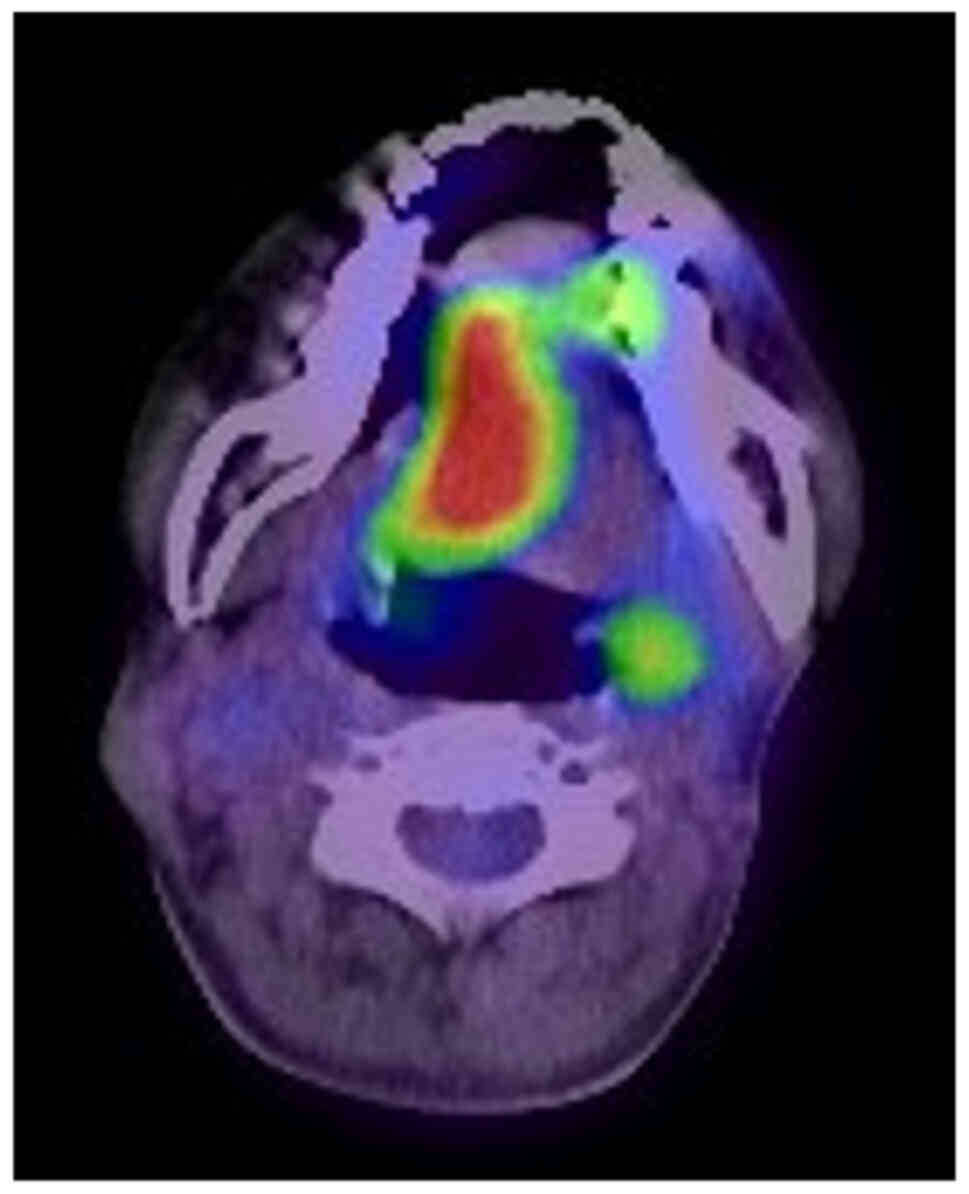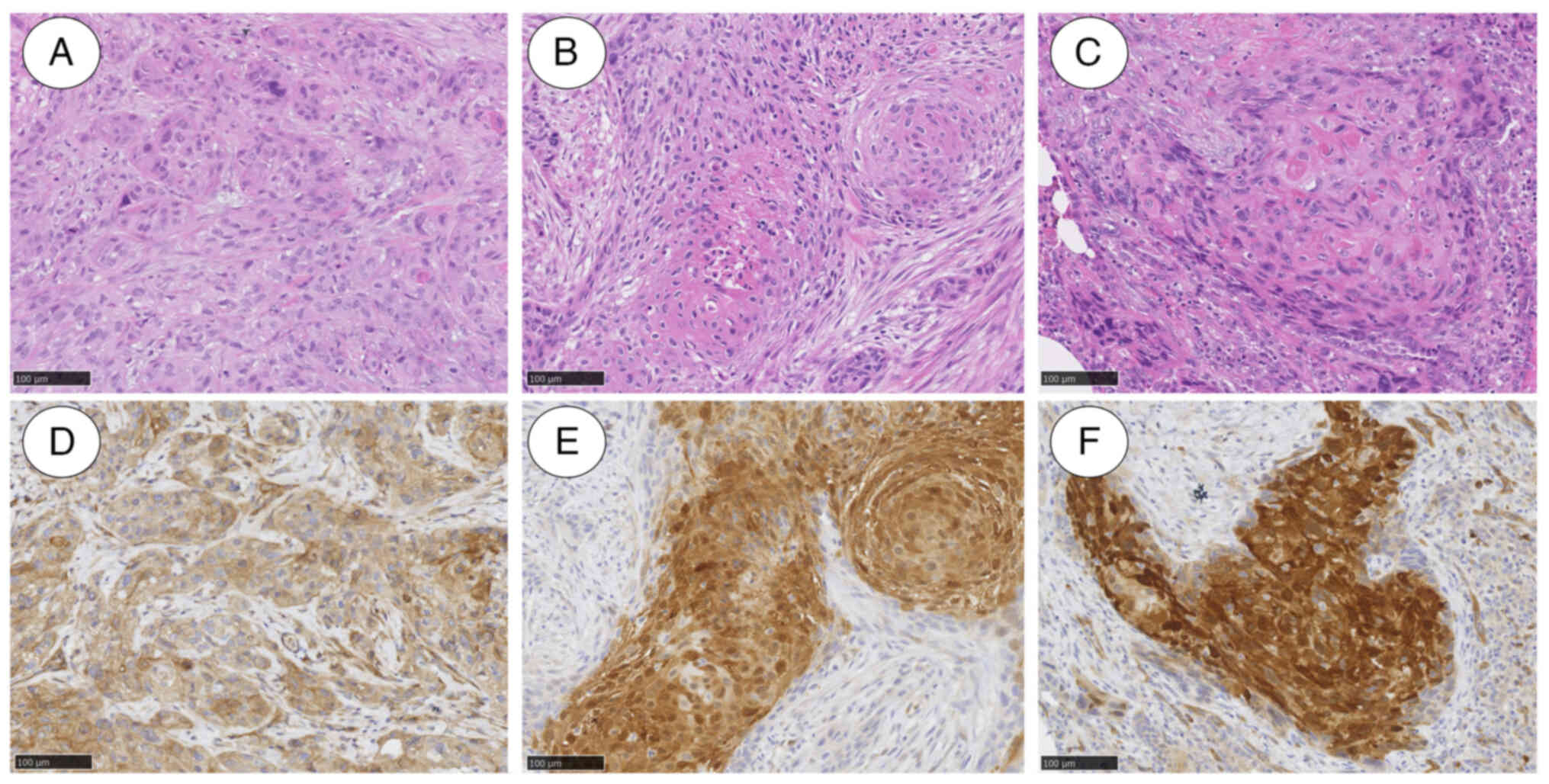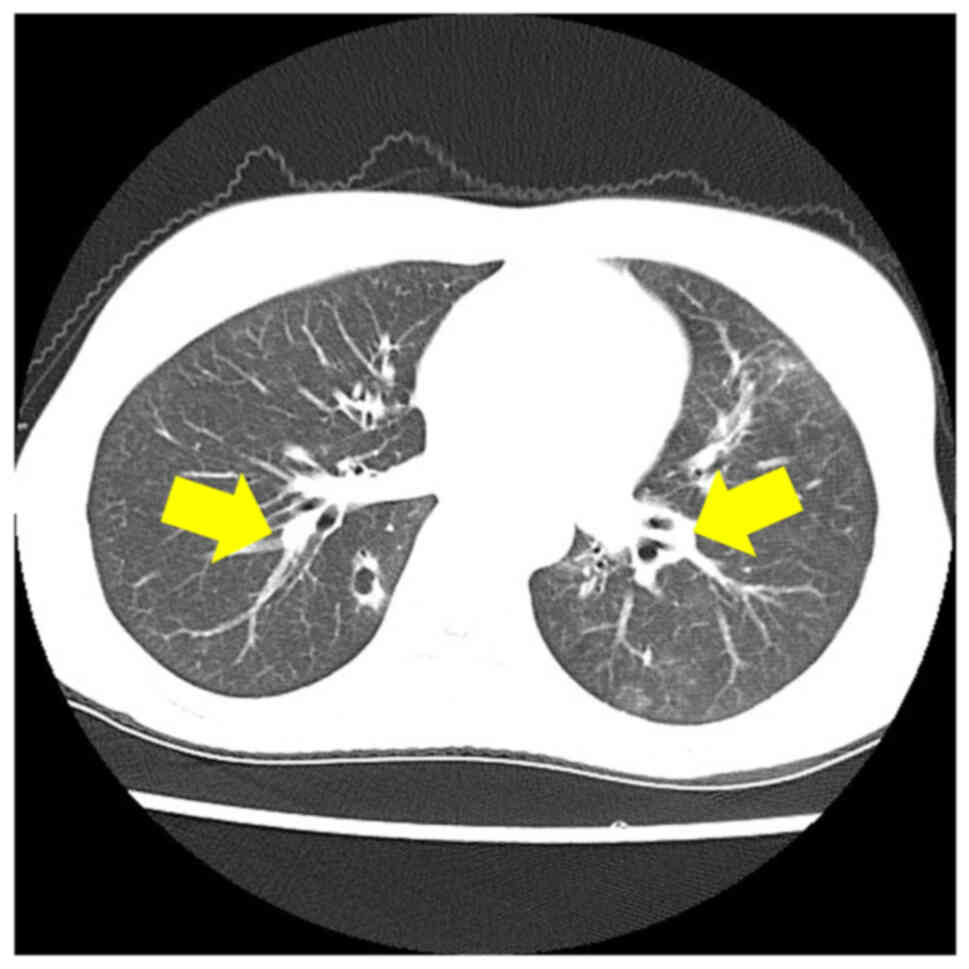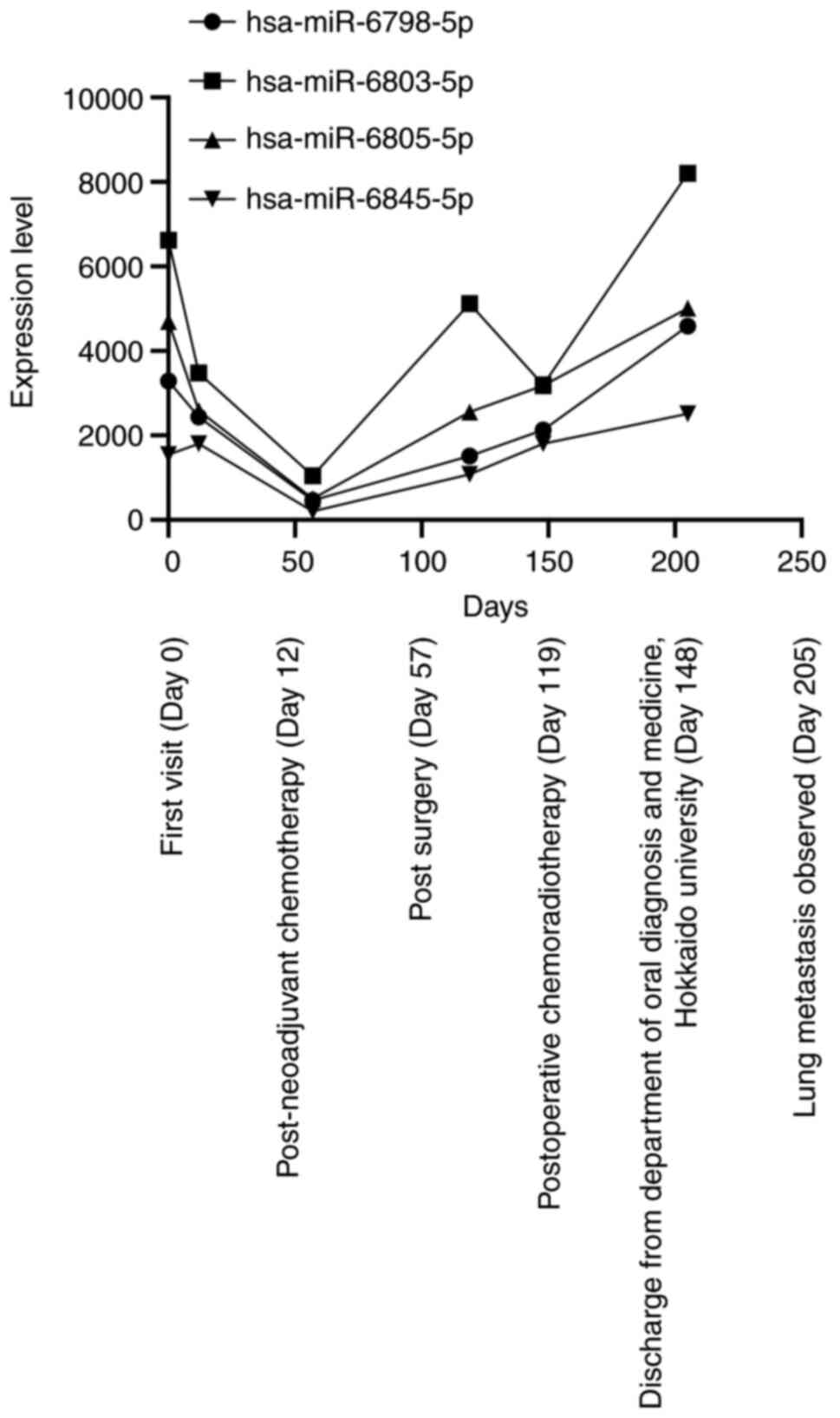Salivary miRNAs as a novel therapeutic marker in a patient with advanced oral squamous cell carcinoma: A case report
- Authors:
- Published online on: November 11, 2024 https://doi.org/10.3892/ol.2024.14798
- Article Number: 52
-
Copyright: © Kimura et al. This is an open access article distributed under the terms of Creative Commons Attribution License.
Abstract
Introduction
Oral mucosal cancer is a common subtype of head and neck cancer, and >90% of oral cancer cases present pathologically as oral squamous cell carcinoma (OSCC) (1). Recently, patients with OSCC, particularly adolescents and young adults, have been increasing as newly diagnosed with this cancer, at approximately 20,000 annually in Japan, for instance (2). OSCC generally exhibits as a red and/or white patched lesion sometimes accompanied by ulceration and bleeding when irritated during progression. These symptoms resemble oral stomatitis; thus, detecting OSCC at an early stage is sometimes difficult. As a result, those with OSCC tend to be diagnosed with locoregionally advanced stages, which carry higher risks of local relapse and metastasis, resulting in poor prognosis with a 5-year survival rate of approximately 50% (3–5). Conversely, patients with OSCC at early stage show favorable outcomes by conventional combined treatment including surgery, chemotherapy, and radiotherapy with their 5-year survival rate of >80% (6). Therefore, detecting this notorious cancer at an early stage is crucial.
MicroRNAs (miRNAs) are endogenous noncoding RNAs with approximately 19–25 nucleotides in length (7). MiRNAs regulate the expression of target mRNAs at the transcriptional and post-transcriptional levels by binding to their 3′-untranslated regions (UTRs) of the mRNAs (7). These processes result in targeted mRNA degradation, and miRNAs function eventually as regulators of biological processes including cell proliferation, differentiation, and apoptosis induction (8). Intriguingly, the miRNAs are reported to have oncogenic and tumor-suppressive functions (9,10). Moreover, each cancer possesses a unique miRNA expression profile, and miRNAs take on an oncogenic or tumor-suppressive role depending on the cancer type (11). This evidence has accelerated the use of miRNAs not only as a diagnostic biomarker but also as a therapeutic and prognostic marker and even as a therapeutic target (8,12). In collecting miRNAs, a previous study reported that miRNAs are protected from degradation by being capsulized with extracellular vesicles such as exosomes, and oral swirl samples enabled isolation of adequate miRNAs (13). Moreover, a recent study demonstrated that miRNAs isolated from oral swirl samples are potential biomarkers for classifying the risk of OSCC development among patients with oral potentially malignant disorders (OPMDs) (14,15).
Herein, this case report aimed to demonstrate further potential availability of salivary miRNAs as therapeutic and prognostic markers of OSCC. To end this, this report presented the case of a patient with advanced OSCC of the tongue and assessed the patient's salivary miRNAs during each clinical course.
Case report
A 33-year-old Japanese woman was referred to our department by her family dentist for an examination of her right-sided tongue lesion. Her medical history included congenital anomaly syndrome, presenting with cranial deformity, brachydactyly, esotropia, and micrognathia. She did not smoke nor drink alcohol regularly. She had noticed the lesion a few months before the first visit to our department and recently noticed it had gotten larger, resulting in difficulty speaking and eating. On extraoral examination, no lymph nodes were swollen in her head and neck region. On intraoral examination, an indurative and hemorrhagic mass measuring 20×30 mm accompanied by ulceration on the right side of the tongue was identified (Fig. 1). Contrast-enhanced computed tomography (CECT) identified the lesion extending beyond the lingual septum presenting 24 mm depth of invasion without any signs of bone invasion (Fig. 2A and B). CECT also detected signs of metastases in a submandibular lymph node (Fig. 2C). Furthermore, CE magnetic resonance imaging identified the gadolinium-enhanced lesion on the right side of the tongue (Fig. 3A and B). Positron emission tomography (PET)/CT found increased uptake of 18fluoro-deoxyglucose in the right-sided tongue, with standard uptake valuemax of 12.893 without apparent increased uptake in bilateral cervical lymph nodes (Fig. 4). An incision biopsy from the right-sided tongue revealed neoplastic proliferation with nuclear atypia and atypical mitoses, representing the findings of SCC (Fig. 5A). Finally, she was diagnosed with right-sided tongue SCC with suspicion of submandibular lymph node metastasis, cT3N1M0.
Subsequently, she received neoadjuvant chemotherapy with tegafur-gimeracil-oteracil potassium 40 mg/day for 2 weeks, showing a stable disease. Thereafter, she underwent subtotal glossectomy, right-sided modified radical neck dissection type III with levels I–V, and left-sided supraomohyoid neck dissection. She further underwent reconstructive surgery with rectus abdominis musculocutaneous flap. Pathological examination revealed SCC with negative surgical margin and four positive nodes (total 4/51 including right-sided level 1B; 1/7 with extranodal extension (ENE), left-sided level 1A; 1/6 with ENE and left-sided lateral retropharyngeal lymph node 2/9) (Fig. 5B). This led to her diagnosis of right-sided tongue SCC with lymph node metastasis, pT4aN3bM0. Subsequently, she received concurrent chemoradiotherapy (CCRT) with 6-week cisplatin (50 mg/m2) and intensity-modulated radiation therapy (total dose: 60 Gy in 30 fractions). Two months after her regimen, regular CT identified aberrant cavitary nodules in both the right and left lungs, suspicious of multiple lung metastases (Fig. 6). During further examinations for the lung lesions (Fig. 5C), she died because of multiple-organ failure 11 months after the initial diagnosis.
For miRNA profiling, resting saliva samples were obtained from the patient at her first visit (day 0), after neoadjuvant chemotherapy (day 12), after surgery (day 57), after postoperative CCRT completion (day 119), at the time of her discharge from our hospital (day 148), and when lung metastasis was detected (day 205) (Fig. 7A). Each sample was collected in the morning before brushing her teeth or rinsing her mouth. Thereafter, total RNA was extracted from the exosome in each salivary sample using 3D-Gene® RNA extraction reagent supplied with a liquid sample kit (Toray Industries, Inc., Tokyo, Japan) (Fig. 7B). To perform miRNA microarray, the total RNA was first labeled with a 3D-Gene® miRNA labeling kit (Toray Industries, Inc., Tokyo, Japan) and hybridized with 3D-Gene® Human miRNA Oligo chips (Toray Industries Inc.). This kit enables the evaluation of 2,632 miRNAs with the microarray chip device. After washing the device, fluorescent signals were scanned with 3D-Gene® Scanner (Toray Industries, Inc.), and their intensity was analyzed using 3D-Gene® Extraction software (Toray Industries, Inc.). Raw data were adjusted by the mean signal intensity of the background, which was calculated based on the mean signal intensities among whole blank spots with 95% confidence intervals. The signal intensity of each spot was verified referring to the signal intensity greater than two standard deviations of the background signal intensity. In addition, global normalization was applied to each verified signal intensity to adjust the median to 25. Furthermore, data were converted into log2 data by the 75th percentile normalization so that the top 25% of its values (75th percentile) become 1. Then, ‘log2 ratio’ was calculated by subtracting each of the 75th percentile of the log-converted data among each sample point. Moreover, the ‘ratio’ was calculated by the antilog transformation referring to the log2 ratio. Finally, this study compared the ‘ratio’ and defined the upregulation of miRNA of interest as the ratio >2 and the downregulation as the ratio <0.5. In this study, the miRNAs that meet following both criteria were determined as candidate biomarkers for OSCC: miRNA displaying 1) downregulation in the postoperative sample compared with the sample obtained on patient's first visit, 2) upregulation in the sample obtained when the lung metastasis was detected compared with the postoperative sample. This study was approved by Hokkaido University Hospital's independent clinical research review committee (Approval No. 020-0085).
As a result, hsa-miR-6798-5p, miR-6803-5p, miR-6805-5p, and miR-6845-5p were significantly upregulated at the first visit to our department (Table I; Fig. 8). Then, these miRNA levels decreased after the neoadjuvant chemotherapy and surgery (day 57) and increased gradually until lung metastasis was detected (day 205). In addition, these four miRNAs were found to contain specific sequences each of which are complementary to those in 3′UTR of kinase insert domain receptor (KDR) gene encoding the vascular endothelial growth factor receptor-2,VEGFR2 (Data S1) (16). Hence, these four miRNAs have a potential to directly recognize the 3′UTR, resulting in controlling the expression level of VEGFR2. Furthermore, immunohistochemical examination showed that VEGFR-2 stained positive in both tongue and lung metastatic cells (Fig. 5D-F).
Discussion
To our knowledge, this is one of the few reports describing the availability of salivary miRNAs as biomarkers for monitoring the therapeutic effect and predicting the prognosis of a patient with advanced OSCC. Herein, the comprehensive microarray targeting miRNA revealed that the patient exhibited remarkable changes in the level of four miRNAs, namely, hsa-miR-6798-5p, miR-6803-5p, miR-6805-5p, and miR-6845-5p, isolated from the salivary samples. In addition, the expression profile of VEGFR-2 regulated by the four miRNAs was observed in both tongue and lung lesions. Moreover, this study revealed that the levels of the four miRNAs dramatically changed in accordance with the clinical course of the patients.
Currently, cancer biomarkers for diagnosis, evaluating the therapeutic effect and predicting patients' prognosis, generally include DNAs, RNAs, and proteins such as metabolites (17). As for OSCC, serum SCC antibody has been employed as a diagnostic and therapeutic biomarker; however, it requires invasive procedure and still has low specificity (18). In addition, collecting sufficient circulating tumor cells that are rarely detected at the early stage and mainly detected at the advanced stages is still challenging (19,20). Recently, miRNAs have been gaining attention as biomarkers given their reliable stability. miRNAs are released by normal and tumor cells as extracellular vesicles such as exosomes, which protect the miRNAs from degradation by RNase (19). So far, several miRNAs have been identified as potential candidates for OSCC biomarkers including miR-137 and miR-29a/b/c in the tumor for diagnostic marker (21), miR-1275 upregulation and miR-222-3p and miR-423-5p downregulation in the plasma for regional lymph node invasion (22), miR-196a and miR-21 upregulation in the tumor for the radiotherapy-resistant marker (23), all of which require further assessment to determine their sensitivity and specificity in a large cohort. However, these markers require invasive procedure, hampering further investigations in a large cohort. Conversely, salivary miRNA offers a noninvasive and straightforward procedure. Indeed, previous papers demonstrated the availability of salivary miRNA to employ as a biomarker for classifying the risk of OSCC development among the patients with OPMDs (14,15). Among the miRNAs mentioned above, our patient also displayed the significant downregulation of miR-423-5p and miR-24-3p after the surgery compared with those obtained from the sample at the patient's first visit. Although these miRNAs did not meet our criteria, they also have a possibility to contribute to OSCC progression. Other than the two miRNAs, our report did not find remarkable changes of miRNA mentioned above during the clinical course. The discrepancy between previous reports and our results should be due to differences in race, ethnicity, sample collection method and sample quality. Previously, it has been demonstrated that the miRNA profile obtained from serum sample varies depending on the host factors (24). Hence, it should be necessary to evaluate the miRNA candidate considering the patients' background.
In our report, miR-6798-5p, miR-6803-5p, miR-6805-5p, and miR-6845-5p levels were remarkably changed; that is, their levels decreased after the neoadjuvant chemotherapy and surgery compared with those at the first visit, and the levels increased when lung metastasis was detected compared with observed after the surgery (Fig. 8). These results support the hypothesis that the four miRNAs were derived from the tumor cells themselves. Hence, these miRNAs have a potential as therapeutic targets of OSCC. Owing to the ease with miRNA inhibitor development and its usability that miRNA inhibitor can affect simultaneously on the multiple genes that are controlled by the targeted miRNA, miRNA-based therapy has been highlighted in treating various diseases (25). To date, several miRNA-based therapies are now under clinical trials for the treatment of various types of solid tumors however, there are no trials among the patients with OSCC (25,26). Of note, a recent paper proposed miR-31-5p as a therapeutic target for OSCC treatment. In the paper, the authors identified that the serum miR-31-5p, which was not determined as therapeutic target candidate in our report, was significantly upregulated among the patients with OSCC (27). The authors also demonstrated that introducing miR-31-5p into normal epithelial cells, HaCaT cells, resulted in accelerating proliferation and a miR-31-5p inhibitor showed remarkable antitumor effect on both OSCC cells in vitro and OSCC patient-derived xenograft mouse models (27). Accordingly, the four miRNAs presented in this report are also worth consideration as the therapeutic target. To prove this, further experiments including investigation of the miRNA function in OSCC cell lines by introducing the overexpression of the miRNA candidate and by administrating the anti-miRNA oligonucleotide to inhibit the miRNA function are required. Further, validating the antitumor effect in mammalian OSCC models by administrating miRNA inhibitors targeting the miRNA candidates should be necessary to support the in vitro experiment. Lastly, it is crucial to perform OSCC tissue-based analysis to confirm the expression level of the miRNA candidate in the specimen, proposing the candidates as the potent therapeutic target.
Moreover, this report proposed the possibility to employ the four miRNAs as a predicting biomarker for distant metastasis of OSCC. This is because the expression level of the four miRNAs were remarkably upregulated when the lung metastasis was observed (Fig. 8). However, further study should be required to conclude the usability of the biomarker by confirming how the miRNAs contribute to OSCC tumorigenesis and by evaluating the availability among a large number of patients with OSCC. Thus far, the four miRNAs have already been reported to have a potential as a biomarker in various types of diseases. As for miR-6805-5p, a previous study reported that miR-6805-5p extracted from urine sample is a potential biomarker for predicting cisplatin-induced nephrotoxicity among patients with head and neck cancer (28). In this study, the authors found that the miR-6805-5p contributes to renal repair and regeneration through the appropriate regulation of the Wnt pathway. In addition, they proposed that miR-6805-5p downregulation may result in the aberrant activation of this pathway, causing kidney fibrosis and damage (28). Moreover, miR-6798 and miR-6845-5p are reported to play roles in hepatocellular tumorigenesis by regulating macrophage polarization in the tumor microenvironment and activating autophagy, leading to chemoresistance to 5-fluorouracil (FU), oxaliplatin, and pirarubicin (29,30). Besides that, miR-6803-5p level was upregulated in the serum sample extracted from patients with colorectal cancer, and the higher level of miR-6803-5p correlated with poor prognosis, proposing miR-6803-5p as a potential diagnostic and prognostic marker (31). In addition, miR-6803-5p is reported to enhance tumor proliferation and provokes inflammation by regulating the protein tyrosine phosphatase receptor type O/nuclear factor-κB axis among the patients with colorectal cancer (31,32). As for our patient, she displayed miR-6845-5p upregulation prior to the chemotherapy and after that, the patient received chemotherapy with tegafur-gimeracil-oteracil potassium, which included 5-FU prodrug. Contrary to the fact that miR-6845-5p upregulation attributes to the resistance to 5-FU (29,30), the patient showed a stable disease with her miR-6845-5p downregulated after the treatment. This outcome may be due to the difference in cancer context, hence miR-6845-5p may not be employed as chemotherapeutic sensitivity in OSCC patients.
Focusing on the function of the miRNAs, our report revealed that each miRNA is associated with the regulation of VEGFR-2 expression. VEGFRs are tyrosine kinase receptors and interact with their ligands, VEGFs, and placental growth factor, promoting angiogenesis. VEGFR includes VEGFR-1 and VEGFR-2 expressed in vascular endothelial cells (ECs), and VEGFR-3 is expressed in the lymphatic ECs (33). Among them, VEGFR-2 largely contributes to mediating VEGF effects such as EC proliferation, migration, survival, and angiogenesis by activating its downstream signaling pathways including phosphoinositide 3 kinase/AKT/mechanistic target of rapamycin and Ras/Raf/mitogen-activated protein kinase/extracellular signal-regulated kinase (34). Thus far, previous studies have demonstrated that tumor cells secrete proangiogenic growth factors to induce tumor-associated angiogenesis (34,35). In this process, VEGF/VEGFR-2 is the most crucial signaling pathway. Hereby, targeting the pathway is being highlighted as a therapeutic target. Currently, several drugs including bevacizumab, an anti-VEGF antibody, and ramucirumab, an anti-VEGFR-2 monoclonal antibody have been approved to tackle exacerbating cancers such as non-small cell lung cancer, adenocarcinoma, and metastatic colorectal cancer (34). As for OSCC, VEGF and VEGFR-2 are generally expressed in OSCC cells, and previous studies have demonstrated that VEGF/VEGFR-2 should be implicated in OSCC development (36–38). Moreover, the OSCC group exhibited higher VEGF levels in their serum than the healthy group, and in addition, high VEGF levels correlated with the development of lymph node metastasis and showed higher clinical stages (37). Consequently, VEGF in the serum should aid in diagnosing OSCC and predicting the risk of lymph node metastasis. As regards the relationship between the miRNA profile and VEGFR-2 expression status in the tumor specimen, in silico analysis identified multiple putative locations in 3′-UTR on the VEGFR-2 mRNA complementary to the four miRNAs (Data S1). Thus, the four miRNAs are proposed to inhibit the VEGFR-2 translation. Intriguingly, this report identified high VEFGR-2 expression levels in the tumor cells in the tongue and lung metastatic lesions (Fig. 5D-F). This result may be due to a certain mutation or deletion in the 3′-UTR that hinder the miRNAs to bind to VEFGR-2 mRNA, resulting in VEGFR-2 overexpression in the tumor specimens. Recently, with the as the advancement of sequence technologies, patients with certain types of cancer have reported to harbor mutations in the 5′ and 3′ UTR regions, which assumes to contribute to cancer pathogenesis (39). Although our report could not confirm the mutations in the patient's KDR gene this time, further whole genome sequencing would reveal the associations between the four miRNAs and VEGFR-2. Therefore, not only the exact interaction between the four miRNAs and VEGFR-2 mRNA but also the mutation profile of VEGFR-2 must be confirmed to employ these factors as OSCC biomarkers. This report presents remarkable changes in the salivary miRNA levels that are associated with controlling VEGFR-2 in accordance with the patient's clinical course, which indicates that VEGFR-2 expression is also a candidate OSCC biomarker. Indeed, the expression of VEGFR-2 appears upregulated in the lung metastatic lesion compared with that observed in the tongue lesion (Fig. 5E and F). Therefore, our results proposed that not only the four miRNA profiles but also VEGFR-2 expression status may be employed as a prognostic biomarker for OSCC.
However, some limitations must be addressed to support the availability of salivary miRNAs. First, this report examined the miRNA profile of a single patient with OSCC and identified the four miRNA candidates; thus, it is not guaranteed that the miRNAs are also applicable to other patients as biomarkers. Considering the genomic heterogeneity of OSCC, more studies are needed to validate the four miRNAs and investigate their availability for other patients with OSCC (40). Focusing on the gene mutation for instance, the expression of miRNAs is reported to be regulated by p53 during miRNA maturation, which implies that TP53 somatic mutation should influence on the miRNA profile particularly among patients with OSCC whose TP53 generally functions aberrantly due to its gene mutations (1,41). In our report, in silico analysis revealed the potential interaction with the four miRNAs and 3′-UTR of p53 mRNA. This result proposed that the four miRNAs contribute to the inhibition of p53 function, promoting tumor cells to cause aberrant proliferation and finally metastasis. Therefore, combining the genetic alteration profile and salivary miRNA profile should lead to the establishment of sophisticated biomarkers. Second, this study could not conclude that the four miRNAs are responsible for the OSCC tumorigenesis, and the four miRNAs would be potent therapeutic and prognostic biomarkers of OSCC. This is mainly because the patient presented in this study had a history of congenital anomaly syndrome. Some miRNAs were reported to play roles in stabilizing the phenotype of organisms, meaning that they are responsible for controlling individual normal development (42,43). Thus, miRNA dysregulation may influence the normal development and may cause malformations (44). Therefore, further examinations are needed to conclude that the four miRNAs are bona fide biomarkers by investigating the association between the miRNA profile and background of congenital anomalies syndrome. Third, this report did not elucidate the underlying mechanisms of action of the four miRNAs in OSCC development and metastasis. Of note, this report could not identify the miRNAs in the tumor specimens, which make it difficult to conclude that the miRNAs are indeed derived from the tumor cells. In addition, since a single miRNA targets multiple mRNAs, we could not conclude that the four miRNAs and VEGFR-2 solely are the key factors for OSCC development. Accordingly, further analysis for establishing salivary miRNAs as a biomarker is required by confirming the localization of the four miRNAs in the specimen and examining the relationship between the four miRNAs and OSCC tumorigenesis in a large cohort.
In conclusion, this case report proposed that the salivary miRNA should provide biological signatures of OSCC cells and may be used as a novel biomarker for early diagnosis, evaluating the therapeutic effect and predicting the prognosis of patients with OSCC.
Supplementary Material
Supporting Data
Acknowledgements
Not applicable.
Funding
Funding: No funding was received.
Availability of data and materials
The microarray data generated in the present study are not publicly available due to containing information that could compromise patient privacy but may be requested from the corresponding author. The other data generated in the present study may be requested from the corresponding author.
Authors' contributions
TK collected the clinical data and wrote the manuscript. TK, KIS, NO, JS, TI, TMu, TMa, MH and HI acquired and interpreted clinical data. AYM, KCH and YH performed the pathological examination. KCH, YH and HI performed and analyzed the experimental examinations. KIS, JS and HI revised the manuscript. KCH, YH and HI confirm the authenticity of all the raw data. All authors have read and approved the final manuscript.
Ethics approval and consent to participate
The present report was approved by Hokkaido University Hospital Independent Clinical Research Review Committee (approval no. 020-0085; Sapporo, Japan). All study procedures were conducted according to the principles of the Declaration of Helsinki.
Patient consent for publication
Written informed consent for the publication of the clinical data, including photos and images, was obtained from the patient.
Competing interests
The authors declare that they have no competing interests.
Glossary
Abbreviations
Abbreviations:
|
CCRT |
concurrent chemoradiotherapy |
|
CECT |
contrast-enhanced computed tomography |
|
EC |
endothelial cell |
|
ENE |
extra-nodal extension |
|
FU |
fluorouracil |
|
OPMD |
oral potentially malignant disorders |
|
OSCC |
oral squamous cell carcinoma |
|
UTR |
untranslated region |
|
VEGFR-2 |
vascular endothelial growth factor receptor-2 |
References
|
Mody MD, Rocco JW, Yom SS, Haddad RI and Saba NF: Head and neck cancer. Lancet. 398:2289–2299. 2021. View Article : Google Scholar : PubMed/NCBI | |
|
Yoshioka Y, Sakaue T, Matsui K, Tsushima K, Obayashi F, Hamada A, Yamasaki S, Hamana T, Sumi K, Kanda T, et al: Clinical investigation of oral cancer in adolescent and young adult generation. Oral Sci Int. 18:126–134. 2021. View Article : Google Scholar | |
|
Braakhuis BJM, Brakenhoff RH and Leemans CR: Treatment choice for locally advanced head and neck cancers on the basis of risk factors: Biological risk factors. Ann Oncol. 23 (Suppl 10):x173–x177. 2012. View Article : Google Scholar : PubMed/NCBI | |
|
Carreras-Torras C and Gay-Escoda C: Techniques for early diagnosis of oral squamous cell carcinoma: Systematic review. Med Oral Patol Oral Cir Bucal. 20:e305–e315. 2015. View Article : Google Scholar : PubMed/NCBI | |
|
Chow LQM: Head and neck cancer. N Engl J Med. 382:60–72. 2020. View Article : Google Scholar : PubMed/NCBI | |
|
Ho PS, Wang WC, Huang YT and Yang YH: Finding an oral potentially malignant disorder in screening program is related to early diagnosis of oral cavity cancer-experience from real world e. Oral Oncol. 89:107–114. 2019. View Article : Google Scholar : PubMed/NCBI | |
|
Ambros V: The functions of animal microRNAs. Nature. 431:350–355. 2004. View Article : Google Scholar : PubMed/NCBI | |
|
Kim T and Croce CM: MicroRNA: Trends in clinical trials of cancer diagnosis and therapy strategies. Exp Mol Med. 55:1314–1321. 2023. View Article : Google Scholar : PubMed/NCBI | |
|
Calin G, Dumitru C, Shimizu M, Bichi R, Zupo S, Noch E, Aldler H, Rattan S, Keating M, Rai K, et al: Frequent deletions and down-regulation of micro-RNA genes miR15 and miR16 at 13q14 in chronic lymphocytic leukemia. Proc Natl Acad Sci USA. 99:15524–15529. 2002. View Article : Google Scholar : PubMed/NCBI | |
|
O'Donnell KA, Wentzel EA, Zeller KI, Dang CV and Mendell JT: c-Myc-regulated microRNAs modulate E2F1 expression. Nature. 435:839–843. 2005. View Article : Google Scholar : PubMed/NCBI | |
|
Calin GA and Croce CM: MicroRNA signatures in human cancers. Nat Rev Cancer. 6:857–866. 2006. View Article : Google Scholar : PubMed/NCBI | |
|
Chen X, Ba Y, Ma L, Cai X, Yin Y, Wang K, Guo J, Zhang Y, Chen J, Guo X, et al: Characterization of microRNAs in serum: A novel class of biomarkers for diagnosis of cancer and other diseases. Cell Res. 18:997–1006. 2008. View Article : Google Scholar : PubMed/NCBI | |
|
Yap T, Vella L, Seers C, Nastri A, Reynolds E, Cirillo N and McCullough M: Oral swirl samples-a robust source of microRNA protected by extracellular vesicles. Oral Dis. 23:312–317. 2017. View Article : Google Scholar : PubMed/NCBI | |
|
Yap T, Seers C, Koo K, Cheng L, Vella LJ, Hill AF, Reynolds E, Nastri A, Cirillo N and McCullough M: Non-invasive screening of a microRNA-based dysregulation signature in oral cancer and oral potentially malignant disorders. Oral Oncol. 96:113–120. 2019. View Article : Google Scholar : PubMed/NCBI | |
|
Balakittnen J, Ekanayake Weeramange C, Wallace DF, Duijf PHG, Cristino AS, Hartel G, Barrero RA, Taheri T, Kenny L, Vasani S, et al: A novel saliva-based miRNA profile to diagnose and predict oral cancer. Int J Oral Sci. 16:142024. View Article : Google Scholar : PubMed/NCBI | |
|
Agrawal A, Balcı H, Hanspers K, Coort SL, Martens M, Slenter DN, Ehrhart F, Digles D, Waagmeester A, Wassink I, et al: WikiPathways 2024: Next generation pathway database. Nucleic Acids Res. 52(D1): D679–D689. 2024. View Article : Google Scholar : PubMed/NCBI | |
|
Passaro A, Al Bakir M, Hamilton EG, Diehn M, André F, Roy-Chowdhuri S, Mountzios G, Wistuba II, Swanton C and Peters S: Cancer biomarkers: Emerging trends and clinical implications for personalized treatment. Cell. 187:1617–1635. 2024. View Article : Google Scholar : PubMed/NCBI | |
|
van Schaik JE, Muller Kobold AC, van der Laan BFAM, van der Vegt B, van Hemel BM and Plaat BEC: Squamous cell carcinoma antigen concentration in fine needle aspiration samples: A new method to detect cervical lymph node metastases of head and neck squamous cell carcinoma. Head Neck. 41:2561–2565. 2019. View Article : Google Scholar : PubMed/NCBI | |
|
Dar GM, Agarwal S, Kumar A, Nimisha Apurva, Sharma AK, Verma R, Sattar RSA, Ahmad E, Ali A, et al: A non-invasive miRNA-based approach in early diagnosis and therapeutics of oral cancer. Crit Rev Oncol Hematol. 180:1038502022. View Article : Google Scholar : PubMed/NCBI | |
|
Prakash N and Pradeep G: Circulating biomarkers in oral cancer: Unravelling the mystery. J Oral Maxillofac Pathol. 26:300–306. 2022. View Article : Google Scholar : PubMed/NCBI | |
|
Kinoshita T, Nohata N, Hanazawa T, Kikkawa N, Yamamoto N, Yoshino H, Itesako T, Enokida H, Nakagawa M, Okamoto Y and Seki N: Tumour-suppressive microRNA-29s inhibit cancer cell migration and invasion by targeting laminin-integrin signalling in head and neck squamous cell carcinoma. Br J Cancer. 109:2636–2645. 2013. View Article : Google Scholar : PubMed/NCBI | |
|
Manikandan M, Deva Magendhra Rao AK, Arunkumar G, Manickavasagam M, Rajkumar KS, Rajaraman R and Munirajan AK: Oral squamous cell carcinoma: microRNA expression profiling and integrative analyses for elucidation of tumourigenesis mechanism. Mol Cancer. 15:282016. View Article : Google Scholar : PubMed/NCBI | |
|
Suh YE, Raulf N, Gäken J, Lawler K, Urbano TG, Bullenkamp J, Gobeil S, Huot J, Odell E and Tavassoli M: MicroRNA-196a promotes an oncogenic effect in head and neck cancer cells by suppressing annexin A1 and enhancing radioresistance. Int J Cancer. 137:1021–1034. 2015. View Article : Google Scholar : PubMed/NCBI | |
|
Alimena S, Stephenson BJK, Webber JW, Wollborn L, Sussman CB, Packard DG, Williams M, Comrie CE, Wang JY, Markert T, et al: Differences in serum miRNA profiles by race, ethnicity, and socioeconomic status: implications for developing an equitable ovarian cancer screening test. Cancer Prev Res (Phila). 17:177–185. 2024. View Article : Google Scholar : PubMed/NCBI | |
|
Diener C, Keller A and Meese E: Emerging concepts of miRNA therapeutics: From cells to clinic. Trends Genet. 38:613–626. 2022. View Article : Google Scholar : PubMed/NCBI | |
|
Li Z and Rana TM: Therapeutic targeting of microRNAs: Current status and future challenges. Nat Rev Drug Discov. 13:622–638. 2014. View Article : Google Scholar : PubMed/NCBI | |
|
Lu Z, He Q, Liang J, Li W, Su Q, Chen Z, Wan Q, Zhou X, Cao L, Sun J, et al: miR-31-5p is a potential circulating biomarker and therapeutic target for oral cancer. Mol Ther Nucleic Acids. 16:471–480. 2019. View Article : Google Scholar : PubMed/NCBI | |
|
Torso NDG, Quintanilha JCF, Cursino MA, Pincinato EC, Loren P, Salazar LA, Lima CSP and Moriel P: miR-6805-5p as a biomarker of cisplatin-induced nephrotoxicity in patients with head and neck cancer. Front Pharmacol. 14:12752382023. View Article : Google Scholar : PubMed/NCBI | |
|
Xiong H, Ni Z, He J, Jiang S, Li X, He J, Gong W, Zheng L, Chen S, Li B, et al: LncRNA HULC triggers autophagy via stabilizing Sirt1 and attenuates the chemosensitivity of HCC cells. Oncogene. 36:3528–3540. 2017. View Article : Google Scholar : PubMed/NCBI | |
|
Li LB, Yang L, Xie GQ, Zhou XC, Shen XB, Xu QL, Ma ZY and Guo XD: The modulation relationship of genomic pattern of intratumor heterogeneity and immunity microenvironment heterogeneity in hepatocellular carcinoma. Oncol Lett. 20:2332020. View Article : Google Scholar : PubMed/NCBI | |
|
Yan S, Jiang Y, Liang C, Cheng M, Jin C, Duan Q, Xu D, Yang L, Zhang X, Ren B and Jin P: Exosomal miR-6803-5p as potential diagnostic and prognostic marker in colorectal cancer. J Cell Biochem. 119:4113–4119. 2018. View Article : Google Scholar : PubMed/NCBI | |
|
Yan S, Cheng M, Duan Q, Wang Z, Gao W, Ren B and Xu D: MiR-6803-5p promotes cancer cell proliferation and invasion via PTPRO/NF-κB axis in colorectal cancer. Mediators Inflamm. 2019:81285012019. View Article : Google Scholar : PubMed/NCBI | |
|
Ferrara N, Gerber HP and LeCouter J: The biology of VEGF and its receptors. Nat Med. 9:669–676. 2003. View Article : Google Scholar : PubMed/NCBI | |
|
Liu ZL, Chen HH, Zheng LL, Sun LP and Shi L: Angiogenic signaling pathways and anti-angiogenic therapy for cancer. Signal Transduct Target Ther. 8:1982023. View Article : Google Scholar : PubMed/NCBI | |
|
Carmeliet P and Jain RK: Molecular mechanisms and clinical applications of angiogenesis. Nature. 473:298–307. 2011. View Article : Google Scholar : PubMed/NCBI | |
|
Araki-Maeda H, Kawabe M, Omori Y, Yamanegi K, Yoshida K, Yoshikawa K, Takaoka K, Noguchi K, Nakano Y and Kishimoto H: Establishment of an oral squamous cell carcinoma cell line expressing vascular endothelial growth factor a and its two receptors. J Dent Sci. 17:1471–1479. 2022. View Article : Google Scholar : PubMed/NCBI | |
|
Edirisinghe ST, Weerasekera M, De Silva DK, Devmini MT, Pathmaperuma S, Wijesinghe GK, Nisansala T, Maddumage A, Huzaini H, Rich AM, et al: Vascular endothelial growth factor A (VEGF-A) and vascular endothelial growth factor receptor 2 (VEGFR-2) as potential biomarkers for oral squamous cell carcinoma: A Sri Lankan study. Asian Pac J Cancer Prev. 24:267–274. 2023. View Article : Google Scholar : PubMed/NCBI | |
|
Pekarek L, Garrido-Gil MJ, Sánchez-Cendra A, Cassinello J, Pekarek T, Fraile-Martinez O, García-Montero C, Lopez-Gonzalez L, Rios-Parra A, Álvarez-Mon M, et al: Emerging histological and serological biomarkers in oral squamous cell carcinoma: Applications in diagnosis, prognosis evaluation and personalized therapeutics (review). Oncol Rep. 50:2132023. View Article : Google Scholar : PubMed/NCBI | |
|
Schuster SL and Hsieh AC: The untranslated regions of mRNAs in cancer. Trends Cancer. 5:245–262. 2019. View Article : Google Scholar : PubMed/NCBI | |
|
Li Q, Tie Y, Alu A, Ma X and Shi H: Targeted therapy for head and neck cancer: Signaling pathways and clinical studies. Signal Transduct Target Ther. 8:312023. View Article : Google Scholar : PubMed/NCBI | |
|
Hermeking H: MicroRNAs in the p53 network: Micromanagement of tumour suppression. Nat Rev Cancer. 12:613–626. 2012. View Article : Google Scholar : PubMed/NCBI | |
|
Gibson G and Wagner G: Canalization in evolutionary genetics: A stabilizing theory? Bioessays. 22:372–380. 2000. View Article : Google Scholar : PubMed/NCBI | |
|
Hornstein E and Shomron N: Canalization of development by microRNAs. Nat Genet. 38 (Suppl):S20–S24. 2006. View Article : Google Scholar : PubMed/NCBI | |
|
Amiel J, de Pontual L and Henrion-Caude A: miRNA, development and disease. Adv Genet. 80:1–36. 2012. View Article : Google Scholar : PubMed/NCBI |



